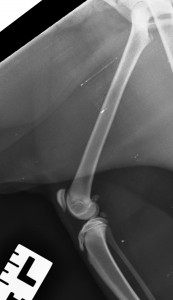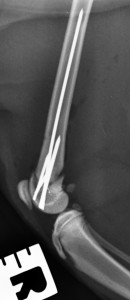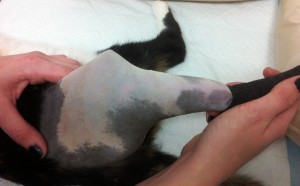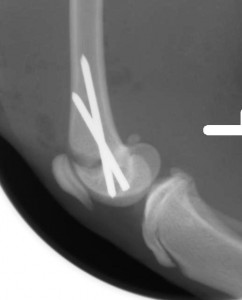Fracture through the weaker cartilage growth plate that is situated at the end of the femur (thigh bone) is relatively common in juvenile cats. These can occur following trauma within the house with the high-jinks that young cats get up to, or after accidents outside, such as road traffic accidents etc.
While growth is occurring this growth plate is a weak point. Once maturity is reached and the growth plate closes over and becomes relatively stronger, then fractures of the diaphysis (the shaft) of the femur are more common as this is then the “weak spot”.
When fractures through the growth plate, the bone ends can become dramatically displaced. Left untreated, this would be a crippling injury, wrecking the future function of the stifle (knee) joint.
The 8 month old cat featured in the pictures below had such a distal growth plate injury sustained following unknown trauma outside of the house environment. We fixed it the next day in the usual way, using crossed pins to hold the small fragment in position against the long bone. Cage confinement is recommended for a few weeks post-op. This is because it isn’t wise to allow jumping, climbing or running on the repair which involves soft young bone, small fragments and small implants. But fortunately the active bone in these young cats heals reliably, and the cage confinement is likely to be rewarded with good or excellent function in the future. Pins occasionally loosen or cause issues later, and can be removed if they are causing a problem.
The operation is a little fiddly as getting good reduction – alignment of the pieces – is critical to success. If not, the patella (knee-cap) might rub against exposed bone on the end of the femur shaft, or it might luxate (fall out) from the groove in which it usually runs. Doing the surgery promptly after the injury is advised, subject to the patient being fit for a general anaesthetic after they are stable following whatever trauma they have suffered.
This young cat had a fractured femur on the left side and a dislocated hip on the other side. Maciej fixed the hip with a toggle procedure (see separate article) which is fiddly in something as small as a cat.
21st December 2013






